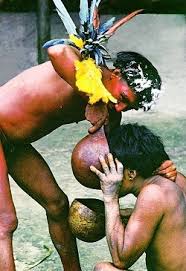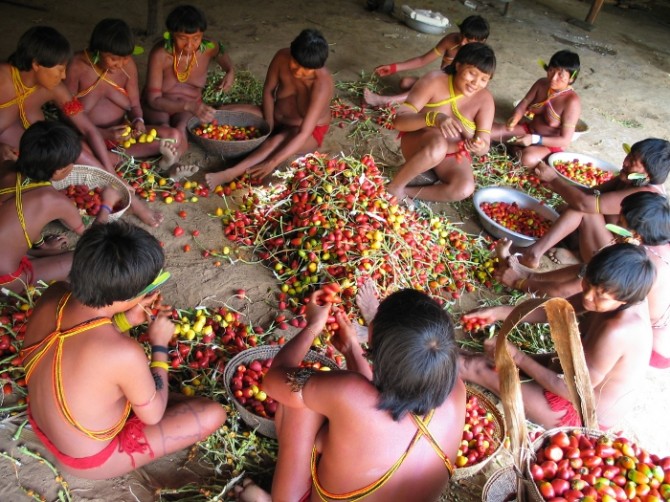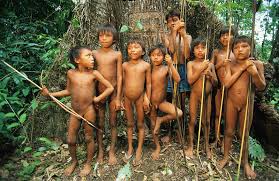
VENEZUELAN INDIANS AND BIZARRE DEATH CULTURE

“Rituals are the formulas by which harmony is restored.”
– Terry Tempest Williams
Unless we are talking about bizarre rituals we are not able to accept and to understand. But, we are still interested to find out more about the controversial moments of one society and its own taboo practice. We are simply addicted to open the covered stories and to smell the burning of the human’s innocence for the sake of primitive and animal fears.
The world travelers who find themselves lost in the mist of some forgotten land, often come back with the Robinson Crusoe inspiration. The scary adventures in deep jungles, the discovery of cannibalistic tribe or the escape of death are not the scenario for some future blockbuster.They are the footprints of modern explorers who bring us the piece of mystical world, the piece we are not always ready to swallow.

The Yanomami tribe is one of the most interesting for the anthropologists because they are the largest indigenous tribe on the South American continent. They are located on the shores of the Amazon, some of them live in the southern part of Venezuela( around 10,000 people) and the rest are in the northwest of Brazil (about 9,000 people). The most exciting fact about them is that they hold on their local customs and backward culture, they do not change their religious frame and practice and they are not exposed to the influence of white settlers or gold seekers who are ready to destroy all for the profit. The Yanomami are also known as Yanam or Senema but almost always like a specific tribe that has very strange death culture, merged with cannibalism. They are presented to the world’s population as a people who eat ash of the death to ensure the salvation of the soul. The term is endocannibalism, what also means eating the flesh of a human being from the same community after they have died or consuming their relics through in the mortuary process.

The social picture of Yanomami Indians is also unique. They prefer life in small groups, where they all enjoy naked, sharing a common tent Shabono. They do not interfere with other communities, only in the case of weddings or wars. Because of the group’s life and activities, men usually get in conflicts with one another and fight each others but according to observations of scientists, the violence is not the attribute of this tribe but rather an unwilling choice. However, the death culture is very substantive in the mentioned community and it is a core of the tribe living cycle and based on Dr. Frank Jacob research:”The religious conviction of the Yanomami rests on the belief that the soul needs to be protected after death, a belief that appeared in European antiquity as well.The soul could enter another life form.Due to this, the Yanomami do not hunt special kinds of birds, which are seen as a possible container for the souls of dead tribe members.Following the religious beliefs of the Indians, the soul is only able to achieve a full salvation if the dead body is burnt after death and if the ash is eaten up by the family and the relatives of the dead person. So, in contrast to the funeral rites which are practiced all around the world, the Yanomami do not bury the corpses.In a ceremony the dead body is burned down and the remaining ash and bones are collected by the remaining relatives.” They express their feelings towards the dead community member through the cries and songs, masking their faces with the grime. After the burning, the bones are picked up and mixed with the ash in some pot where they stays until the second part of the ceremony of death ritual. In the afterphase, they collect the bones, make them pulverized and mix with banana, making famous banana soup which will be consumed by all. Banana mush is the most popular dishes of these native Indians so it doesn’t surprise their interest to make it from the ash and bones of dead tribe member. They believe that is the only way of successful and right journey of the soul to the paradise, through the other who eat it. If there is no full ceremony, the soul is damned and without peace.


The endocannibalism is not a typical cannibalism but the form of indirect cannibalism, in some spiritual way. The Yanomami do not see anything wrong in this but they see wrong if the ritual is not made and the soul is cursed to wander between this world and the another one. I found very interesting that Yanomami prior to cremation, cover the body in leaves and let the nature to do the rest of the job. Natural decomposition usually takes up to 45 days, calculating the fast work of insects.
The consumption of ashes in one sitting is obligatory but there are situations when we have exceptions, especially when the enemy have killed the Yanomami member:”Rather than the entire community consuming the ashes, only the women must do it, and it has to happen on the night that a revenge raid is planned. The ashes of these men killed by enemies may linger around for years until the tribe believes that their deaths have been rightfully avenged. This is due to the Yanomami tribe’s belief that the spirit cannot completely transition to the spiritual world without completely vanishing from the material world. Therefore, the ashes cannot be fully consumed until the matter of avenging the death is resolved so that the late loved one can make the peaceful transition to the spiritual world.”

Maybe it is not a real comparison, but the Aghori monks of Varanasi in India have the similar ideas about endocannibalism. They believe that they will achieve the majestic spiritual power if they consume the parts of the dead or their ash. It is one primitive belief that the relics give them power to communicate to the world of dead. There were many scandalous stories about those monks but at the end of the day, they are not monsters and killers. They are dwelling into the shadows between the two worlds, preying on dead souls and their journey to the life after this one.

The Yanomami are far away from the mysticism of Aghori monks. They are still stuck in their own cultural taboo and in their own glorification of death rituals. For hundred years, nothing has been really changed within the vibrant tribes in the rainforests of the Amazon. Considering them violent and dangerous is not a real effort when they are one exclusively indigenous tribe per se. The endo cannibalistic characteristic of their tribe religion is nothing but the proof that civilization manners will never achieve every single corner of the Earth. It will be always the places and the people who will be enough distant to resist the wheels of the mankind’s progress and who will always turn their Gods into our nightmares. Regardless how, their unique anthropological identity is a challenge for all of us, everytime we think of deep, ancient jungles and their own rules.

Thank you, Sarah, for shedding light on this ancient ritual which still exists in today’s world!
It is amazing how the Yanomami tribe rituals have survived modernization that’s all around!
This comes from a mutual intent on the part of both the tribe, i.e. from the inside, and the Venezuelan government on the outside!
While one ca understand how the Yanomami tribe wishes to preserve its mores over the centuries, it is hard to believe and comprehend why and how the Venezuelan government allows such odd rituals to continue.
In general, cannibalism has been rejected over the years as an unacceptable act on the part of humans, and so should endocannibalism !
It is unsanitary to leave the dead for 45 days to decompose, as this would harbor and foster microbes and bacteria, which could bring about deadly diseases that may decimate the tribe members!
As you have stated in this article, primitive rituals are not unique to the Yanomami tribe. It is the duty of the rest of the world to reach out to theses types of tribes, wherever they may be, to enlighten them as to such unhealthy rituals.
Thank you again, Sarah, for this anthropologically informative article !
LikeLike
Sarah’s intriguing article brought to mind three entities associated with cannibalism: ritualism, necessity and unconscious cannibalism.
In 1846, the North American author Herman Melville (1819-1891) wrote the treatise Typee: A Peep at Polynesian Life; a semi-factual account of Herman Melville’s voyage to the South Pacific Island of Nuku Hiva (the largest of the Marquesas Islands of French Polynesia), where he lived for several weeks among the island’s cannibal inhabitants, before fleeing.
It is still debated why many Polynesian tribes practiced cannibalism. Indeed, a large number of Pacific Island residents did so in prehistoric times. One theory is that cannibalism was more for food than ritualism; although, ritual played a significant part. An offering to the gods was called Ika (which means fish), and a sacrifice was caught and, just like a fish, was hung by a fishhook in a sacred place.
Those to be eaten were tied and hung up in trees until needed. Then, they had their brains bashed out on execution blocks with a club. Women and children seem to have been cannibalized just for food, whereas warriors killed in battle were offerings to the gods and were eaten by their conquerors to absorb their power. Their skulls were kept by their slayers for the same reason.
In the context of cannibalism as necessity, the infamous case of Alexander Pearce (1790-1824) came to mind: he was an Irish convict who was transported to Van Diemen’s Land (Tasmania, the most horrifying Gothic prison in The British Empire) for seven years for theft. He escaped from prison several times. During one of these escapes (1822) he allegedly became a cannibal; murdering his companions one by one. In another escape, with one companion, he allegedly killed him and ate him in pieces. He was captured and was hanged and dissected in Hobart, Tasmania.
Chemically, red meat does possess elements that interact with the blood system of humans (i.e. influences on the neurological system and brain) in a very different manner to fruit, vegetables, etc. Alexander Pearce started out being a cannibal from the pressures of extreme hunger and near starvation, while absconding in the harsh climate and topography of Tasmania. Arguably, the ingestion of human flesh brought forth the foundations of what might have become ritualism, if he had continued consuming human flesh. Psychologically, he was being metamorphosed by what he was eating. Such as the aggression levels in carnivores (i.e. Homo sapiens, lions and other mammals, and even plants [e.g. Venus fly trap]).
Lastly, I refer to ‘unconscious cannibalism’, when people do not know they are consuming humans. The futuristic film Soylent Green (1973) is set in a dystopian future suffering from pollution, overpopulation, depleted resources, poverty, dying oceans and year-round humidity due to the greenhouse effect. Much of the population survives on processed food rations; including ‘soylent green’ (humans processed into edible food).
It is not improbable that this could happen in the future, because we are already in a very serious situation of global food production. There are natural resource issues all over the planet (i.e. food, water and oxygen). People will eat anything, if they are told lies about what they are eating, because most humans do so now (i.e. issue of false labeling of food products, etc.). For example, the dire consequences of saturated junk food are sustained through the noxious ignorance of consumers.
Sarah’s article should be published in either or Scientific American and National Geographic: her unique and engaging journalism proffers up enlightenment for all wishing to comprehend the diversities and varieties of organic life on Earth, physiologically and psychologically.
LikeLike
Great goods from you, man. I’ve remember your stuff previous to and you’re just too magnificent.
I actually like what you have acquired right here, certainly like what you’re
saying and the way in which wherein you assert it.
You make it enjoyable and you still care for to keep it smart.
I can’t wait to read much more from you. This is really a tremendous web
site.
LikeLike
Greetings! Very helpful advice within this article! It is the little changes which will make the most significant changes. Thanks a lot for sharing!
LikeLike
great put up, very informative. I’m wondering why the opposite specialists of this sector do not notice this. You must continue your writing. I’m sure, you have a huge readers’ base already!
LikeLike
I can’t believe how great this site is. You keep up the good work. That’s my advice pal.
LikeLike
Just fabulous. Who wrote this and how can we get more?
LikeLike
I just got done eating a platter of spaghetti before visiting your site. It sure makes the full feeling all that much better.
LikeLike
Where did you site this information from ? I am a uni student and need peer reviewed articles for my Anthropology assignment !
Thanks, real interesting information
LikeLike
Heya! Can you intellect easily discuss your site together with our twitting class? There’s many people that I believe could revel in your articles. You need to ok, i’ll understand. Thanks!
LikeLike
Some very problematuic wording here –> Primitive, backward.
LikeLike
Wow, beautiful site. Thnx …
LikeLike
its excellent as your other posts : D, thankyou for putting up.
LikeLike
It’s actually a great and helpful piece of information. I’m glad that you just shared this helpful information with us. Please stay us informed like this. Thank you for sharing.
LikeLike
You are so awesome! I do not think I’ve truly read a single thing like that before. So good to find another person with some genuine thoughts on this issue. Seriously.. thank you for starting this up. This web site is something that’s needed on the internet, someone with a little originality!
LikeLike
Howdy would you mind letting me know which webhost you’re using? I’ve loaded your blog in 3 completely different web browsers and I must say this blog loads a lot faster then most. Can you recommend a good hosting provider at a reasonable price? Cheers, I appreciate it!
LikeLike
Regards for sharing the information with us.
LikeLike
I for all time emailed this blog post page to all my friends, as if like
LikeLike
Your article normally possess much of really up to date info. Where do you come up with this? Just declaring you are very resourceful. Thanks again
LikeLike
Exceptional post but I was wanting to know if you could write a litte more on this subject? I’d be very grateful if you could elaborate a little bit further. Appreciate it!
LikeLike
Awesome blog you have here but I was wondering if you knew of any message boards that cover the same topics discussed here? I’d really love to be a part of group where I can get opinions from other knowledgeable individuals that share the same interest. If you have any recommendations, please let me know. Appreciate it!
LikeLike
I think this is among the most significant info for me. And i’m glad reading your article. But should remark on some general things, The site style is great, the articles is really nice : D. Good job, cheers
LikeLike
I am forever thought about this, thankyou for putting up.
LikeLike
Hi there! Do you use Twitter? I’d like to follow you if that would be okay. I’m absolutely enjoying your blog and look forward to new updates.
LikeLike
Hi! This post couldn’t be written any better! Reading this post reminds me of my good old room mate! He always kept chatting about this. I will forward this page to him. Pretty sure he will have a good read. Many thanks for sharing!
LikeLike
I just added this web site to my google reader, great stuff. Can not get enough!
LikeLike
You made some decent factors there. I appeared on the internet for the issue and located most people will go along with with your website.
LikeLike
Please let me know if you’re looking for a author for your weblog. You have some really great posts and I feel I would be a good asset. If you ever want to take some of the load off, I’d love to write some articles for your blog in exchange for a link back to mine. Please shoot me an email if interested. Thank you!
LikeLike
some truly fantastic work on behalf of the owner of this site, dead great content.
LikeLike
Oh my goodness! an amazing article dude. Thanks Nevertheless I’m experiencing situation with ur rss . Don’t know why Unable to subscribe to it. Is there anyone getting similar rss drawback? Anyone who is aware of kindly respond. Thnkx
LikeLike
Thanks for one’s marvelous posting! I genuinely enjoyed reading it, you’re a great author.I will remember to bookmark your blog and definitely will come back down the road. I want to encourage that you continue your great job, have a nice evening!
LikeLike